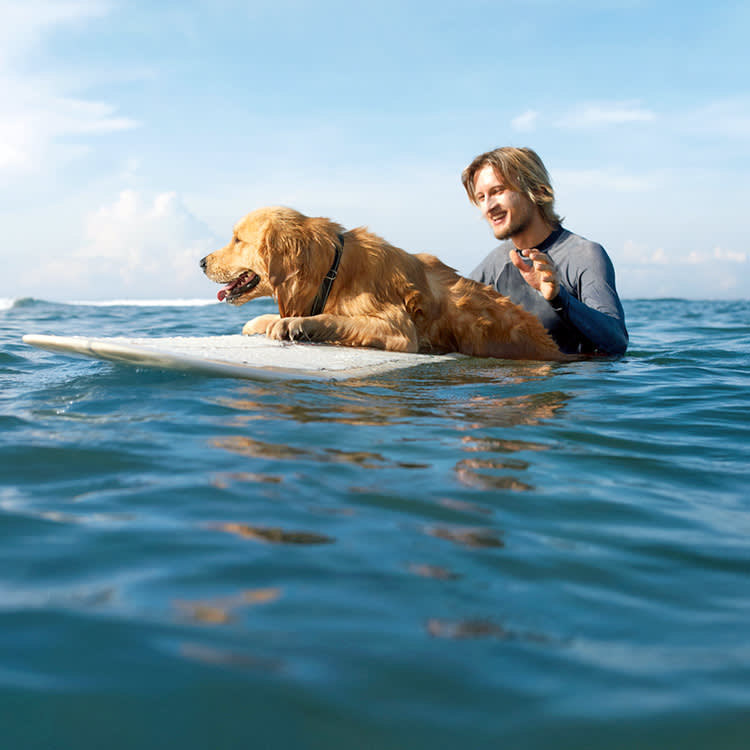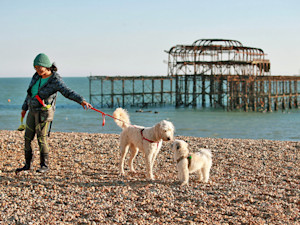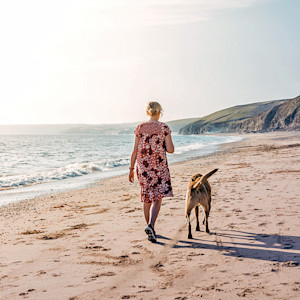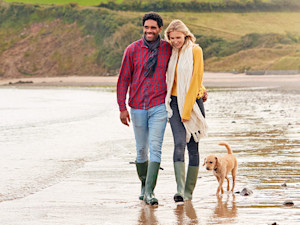Catch the Wave: The Ultimate Guide to Dog Surfing
Let it rip...
There are few things better in life than a beach day with your favourite canine companion, whether it’s the long sandy walks, Frisbee fetchopens in new tab or beautiful coastal vistas that get your tails wagging. But there’s another seaside activity that many British pooches and their owners have turned to in recent years: dog surfing. With pros like Scooteropens in new tab – who works as a canine assisted surf therapy dog for The Wave Projectopens in new tab, which aims to help young people’s mental health and well-being through surfing across the UK – making a splash online, dog surfing has become so popular that there’s even a UK Dog Surfing Championshipopens in new tab held in Dorset, on its sixth edition (move over, dog skateboardingopens in new tab). Of course, this is Britain, so although the weather may not resemble, say, the sunshine of California, teaching your dog to surf is still a unique form of exercise and a chance to bond with your best friend. Plus, it looks really, really fun.
Is it safe for dogs to surf?
Like any activity your pet partakes in, ensuring their safety and well-being is prioritised when you teach them how to surf is paramount. “I believe that dogs can enjoy surfing if they have the correct training, preparation and safety measures,” says Zoe Blakeopens in new tab, a veterinary nurse and animal behaviourist. She goes on to say that only those with a clean bill of health should be considered for surf training. “Joint problems and dogs with respiratory issues would definitely not be suitable,” she stresses. “Surfing requires strength and endurance, so these are factors that should also be considered.”
Zoe also explains that there are some breeds who are naturally better swimmers and more suited to water activities such as Labradors, Retrievers, Spaniels, Newfoundlands and Beagles. Brachycephalics (breeds with shorter noses) like Pugs and Bulldogs may have difficulty breathing in water. Zoe also points out that puppies and older dogs may struggle, especially with their size being influential as to whether they can balance on a surfboard successfully.
How to keep your dog safe in the sea
Zoe says that assessing your dog’s comfort level with water and their swimming abilities is essential. It might sound obvious, but if they’re not a fan of the water then surfing may not be the hobby for them and you should never force an anxious dog to do something they’re uncomfortable with. If they’re not a confident swimmer, put the time and effort in to make sure they are before rushing for the surfboard. Equally, if you as their human are not confident in the sea and equipped with an understanding of tides and water safety, then take time to learn before introducing your pup into the situation.
It’s also a good idea to spend some time with your dog at the beach on a number of occasions beforehand, so they’re familiar with the environment before you begin teaching them the basics. Likewise, if they have never been in the sea, introduce them gently and slowly before even thinking about surfing.
In general, it is safe for dogs to swim in the sea – it can be great exercise for them. But before taking them to the water, take note of a few precautions.
Your dog may be a strong swimmer, but large rolling waves can still be very dangerous. Before you take your dog to the beach, it’s important to check the water conditions. Some beaches may have rip currents or other hazards that could be dangerous for dogs. In these conditions, you might want to save surfing for another day.
Beware of other animals and wildlife. Scan both the water and sand for crabs and other marine life, which can be dangerous for dogs. Be aware of sea lice that can cause itchy red bumps on dogs. Prevent your pup from rolling in or eating anything that could make them sick. Be especially mindful of areas that have a high volume of jellyfishopens in new tab. Another tip: discourage your dog from eating sand. Too much sand ingested can create an impaction in their intestine causing their intestinal tract to close up.
Monitor salt water ingestion. Your dog may want to lap up the sea water if they’re thirsty, but the salt, bacteria and parasites in the water can make them sick. While at the beach, dogs can get dehydrated quickly in the sun, so it is imperative that you prevent your dog from drinking salt water by providing them with plenty of fresh water. Drinking too much salt water can lead to salt water poisoning, vomiting after swimming and ‘beach diarrhoea’.
While scorching hot days are not exactly a common occurrence in the UK, they do happen. Just like people, dogs are at risk for heat-stroke and dehydration when temperatures rise. If you’re uncomfortable in the sun, your dog probably is, too, so stick to early mornings or early evenings to escape the heat.
Sunscreen: if it’s a particularly hot day, limit your dog’s exposure during peak sun hours (between 10am and 3pm) and apply doggy sunscreenopens in new tab 30 minutes before going outside.
Protect their paws from hot sand: hot sand (and pavement) can easily exceed comfortable temperatures for delicate paw pads leading to blisters. If the sand is too hot for you to walk barefoot, then it’s too hot for your pup’s paw pads. Save your beach trip for a cooler day, or go in the early morning or late evening to avoid the heat.
Heat-stroke: running on the sand is strenuous exercise, and this can easily lead to heat-stroke in dogs. And never, ever leave your dog unattended in your car in the summer months – even while you’re loading and unloading your car at the beach. Heat-stroke and death can occur within minutes even in warm temperatures.
The benefits of teaching your dog to surf
Now for the fun part: in addition to providing endless opportunities for top-tier social media content (just look at Rosieopens in new tab go!), what other benefits does teaching your dog how to catch a wave provide? Firstly, surfing is a form of physical activity – it can improve muscle strength and promote cardiovascular healthopens in new tab for both dogs and humans, and is undeniably a fun way of shaking up the usual walk in the park as a means of exercise.
Teaching your dog how to surf isn’t just about training their bodies, either – it’s also about training and enriching their minds with a brand new (and dare we say, very cool) skill. Plus, the teaching process can strengthen your own relationship with them. Taking on a new challenge together isn’t just exciting, but it’ll create new memories, improve their confidence and enhance your relationship.
Oh, and teaching your pooch how to surf is a pretty special way of being able to enjoy some of Britain’s beaches (we’ll get on to which ones are best later in the article), especially if the bog standard fish and chips and helter skelters of the seaside don’t quite cut it for you.
How to get started
Vicky Mansfield is the founder of Paws on Boardopens in new tab, which has provided dog surfing and SUP (stand up paddleboarding) classes and one-to-one training in the Bournemouth area for five years. She started offering training after seeing many owners attempting to teach their dogs to surf unsuccessfully (and sometimes unsafely) on her local beach, and is in the process of writing her own book for beginners wanting to get their dogs into the sport. Her key piece of advice? “Make sure to keep your dog in their happy place, and don’t force them to do anything they don’t want to. My best advice is to take your time – always!”
But before hitting the shore yourself, it’s important to take the time to do your research, especially when it comes to purchasing a surfboard for your dog. They’re available in all shapes, sizes and depths, so it can be a bit tricky to know where to start. Vicky says that a very important starting factor to consider is the board’s buoyancy (its ability to float in water) in relation to the size and weight of your dog. A general rule for any species of surfer is that higher volume boards provide more stability and are better suited for beginners, as lower volume boards become harder to balance on.
“The average board is around 10ft long and 34 inches wide with a depth of 6 inches, which provides a suitable level of balance and support for most dogs,” says Vicky. Select a round-nosed board for further stability, and ensure the board is a soft top as opposed to fibreglass or epoxy. A soft top will allow your pooch to dig their claws into the board’s surface, giving them more grip and reducing the chances of them sliding off. Retailers including Osprey Acion Sportsopens in new tab, Boardshopopens in new tab and the Sorted Surf Shopopens in new tab all sell ranges of boards perfect for beginners.
If you can’t get to Vicky’s classes in Bournemouth, there are plenty of resources online that provide tips, advice and guides on how to teach your dog to surf, like this video from the Helen Woodward Animal Centeropens in new tab in San Diego.
Step-by-step: how to teach your dog to surf
Now you’ve got the board sorted, it’s time to put your pup through their paces so they can get well on their way to becoming the next Bono the Labradoropens in new tab or Ricochet the Golden Retrieveropens in new tab.
Acclimatising them to the surfboard on land
You want your dog to be as comfortable as possible on a surfboard, so the trick is to introduce them to one as soon as possible. Let them stand on, sit on and explore one however they’d like on land to increase their familiarity. Offering them treats on a board is another good way of letting them know that the board is a positive, safe space.
Practising balance and cues
Dogs are often only used to walking on stable surfaces, and surfing is all about being able to remain balanced on your feet. Gradually introduce your dog to a variety of surfaces to improve their balance, their confidence and to get them thinking about their footing and how they sit on unstable surfaces – small trampolines and wobbleboards are great safe pieces of equipment to do this on.
Introducing the dog to the board in shallow water
Next up, head to the sea! Gently slide the board into some calm shallow water and spend some time with your dog in the water before getting them to stand centred, about two-thirds of the way back so the board remains flat and stable. Make sure to gently move the board from side to side so they get an understanding of how the board moves. This step will take a while, so be patient and be sure to offer positive reinforcement and treats along the way.
Practise in calm waters before advancing to small waves
Once your dog feels comfortable on the board in water, slowly begin to take them out to small waves (avoiding any hazards like rocks, etc). Signs that your dog may not be comfortable include excessive whining or barking, tail-tucking, yawning or pawing at you. If you spot any of these signs, take them out the water and try again another day – if these signs of anxiety persist, then surfing may not be for them. Begin slowly and don’t rush the process of trying to catch a wave, this is a brand new activity for your dog so it’ll take some time!
How to keep your dog safe while surfing
A well-fitted dog life jacketopens in new tab is essential, even if you believe your dog is a good swimmer. As time goes on in the water they will tire, so the added help of a life jacket to help them float will be needed – plus, a life jacket will help you spot them when they inevitably fall off the board. Another tip: it’s best to get your dog used to wearing the jacket at home to avoid overwhelming them on your first surfing trip.
To avoid a stressed pup, Zoe suggests that owners keep a keen eye on their dog’s behaviour and body language during training. While human surfers are blessed with wetsuits to keep them warm, the same can’t be said for our four-legged friends. If you spot any signs that they could be cold such as shivering or lethargy, or that they‘re bored (they’ll naturally get restless after repeating the same steps over and over again) or tired, make sure to allow plenty of time for breaks and chill time. “If you notice any fizzy behaviour, they have been pushed too far or have hit their threshold,” says Vicky. “Take a break or take their training back to a safer, happier level.”
Alongside a beach’s busyness (a crowded beach provides more distractions and could stress your pooch out), another important element to keep your eye on is the weather. Surf on milder days, as cold conditions (which aren’t exactly uncommon in the UK) and hotter summer days can present risks to your dog’s health, especially when they’re partaking in exercise for extended periods of time.
It’s essential to recognise the early signs of heat-related illness in dogs to act swiftly. Symptoms of mild heat-related illness include:
Excessive panting that doesn’t subside with rest.
Difficulty breathing, especially if accompanied by unusual noise or a blue/grey tinge to gums or tongue.
Unusual tiredness or lethargy.
Changes in behaviour, such as lying down more frequently and stumbling.
Reluctance to play.
If untreated, these symptoms can progress to heat-stroke, which is characterised by:
severe difficulty breathing
diarrhoea and/or vomiting
seizures
bleeding under the skin
collapse and unresponsiveness
Where to surf with your dog in the UK
Not every beach in the UK will welcome your canine companion to their waters – and ones that do may have restrictions in place throughout the year, so it’s best to checkopens in new tab before planning a visit. Some dog-friendly beaches across the UK include:
Wales
Rhossili Bay, Swansea
Freshwater West, Pembrokeshire
Conwy Morfa, Conwy
Monkstone Beach, Pembrokeshire
Scotland
Luskentyre, Isle of Harris
Mellon Udrigle Beach, Highlands
Saltcoats Beach, North Ayrshire
Belhaven Beach, Dunbar
South West England
Weymouth Beach, Dorset
Brean Beach, Somerset
Woolacombe Beach, Devon
Porthmeor Beach, Cornwall
South England
West Wittering, West Sussex
Camber Sands, East Sussex
Palm Bay Beach, Kent
Whitstable West Beach, Kent
East England
Holkham, Norfolk
Sutton-on-Sea, Lincolnshire
Brancaster Beach, Norfolk
Great Yarmouth Beach (South), Norfolk
North England
Formby, Lancashire
Alnmouth, Northumberland
Cayton Bay, North Yorkshire
Bispham Beach, Lancashire
Common challenges and how to overcome them
Although we’ve touched on some of the problems a dog may experience and how to remedy them (an unfamiliarity with water, beach distractions or a lack of balance), Vicky says the most common problem she sees with dog surfing actually has nothing to do with our four-legged friends. “There can be a real lack of patience from pet parents,” she says. “A lot of people want the success of seeing their dog surfing without putting in the work. They can’t wait for the result so they rush the process.” She stresses the importance of regular breaks, remaining calm and patient and taking your time to make the experience as safe and fun as possible.
It’s hard to argue with: surfing makes for a pretty cool (and unique!) pastime to share with your dog. It ticks a lot of boxes, too: it’s a different form of exercise, it provides mental stimulation and it’s yet another opportunity for you to strengthen your bond with your pet – plus, who doesn’t love spending time with sand in between in their toes, or paws? Even if it turns out that your dog isn’t a natural born surfer and isn’t the next viral sensation, there’s nothing wrong with giving something new a go and enjoying a brand new experience together. And if they do take to the board like a duck to water, entries for the 2025 Dog Surfing Championshipsopens in new tab are open… As the famous surf quote goes, “If in doubt, paddle out!”










